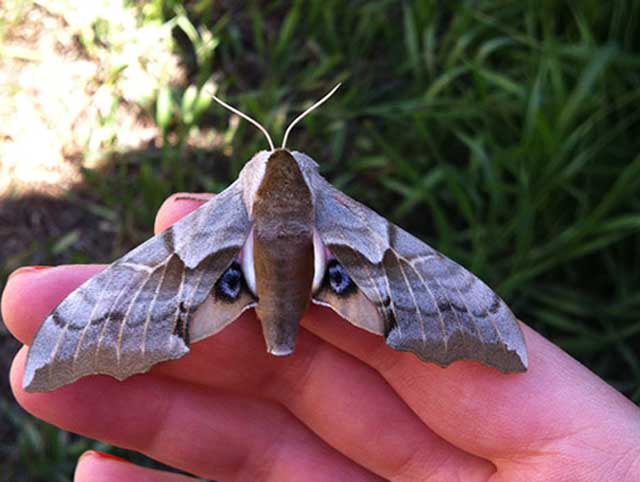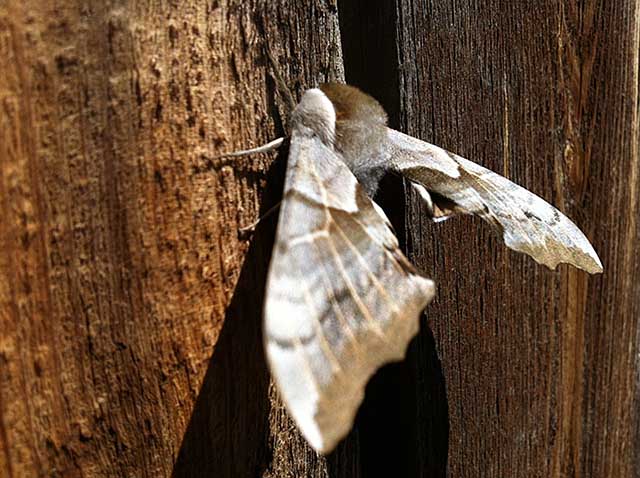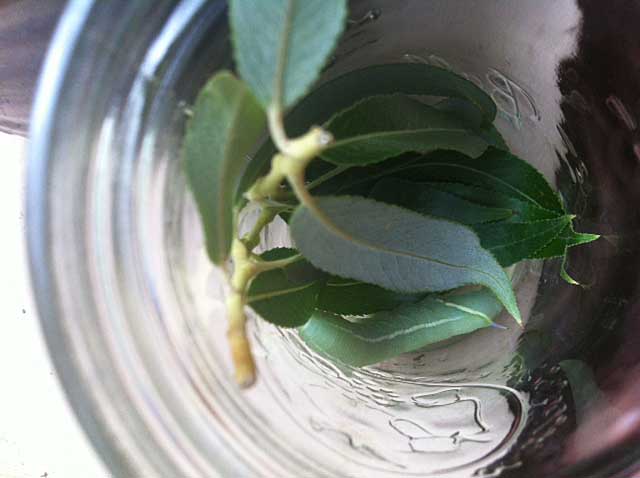Sphinginae subfamily
Sphingini tribe:
 |
This species is a strong migrant and adults nectar from deep-throated
flowers including moonflower (Calonyction aculeatum), morning
glory (Convolvulus), honey suckle (Lonicera) and
petunia (Petunia species).
|
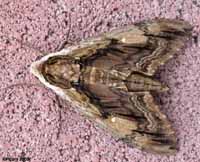 |
Ceratomia amyntor
WO,
the Elm Sphinx or Four-horned Sphinx:
The upperside of forewing is brown with dark brown and white
markings including a white costal area near ing base, dark
streaks along veins, and a white spot in cell.
Larvae feed on Elm (Ulmus), birch (Betula), basswood (Tilia), and cherry (Prunus). unlikely
|
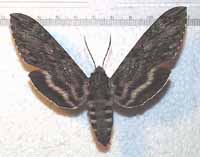 | The upperside of the forewing is dark gray with black and light gray
wavy lines. The upperside of the hindwing is black with a brownish
gray border and two white bands.
|
 |
Manduca quinquemaculatus
WO, the Five-spotted Hawkmoth
The moth abdomen usually has five but sometimes six pairs of yellow
bands. The upperside of the forewing is blurry brown and gray.
Larvae feed on tomatoes and go by the common name of
"Tomato Hornworms". |
 |
Look for three large yellow spots
on each side of the abdomen. The upperside of the forewing is
yellowish brown to deep chocolate brown with a dusting of white
scales and zigzagged black and white lines. possible stray
|
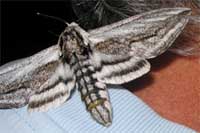 |
The upperside of the forewing has a wide white band along the costa
from base to apex. The remainder of the wing has black and white
bands.
|
 |
The upperside of the forewing is pale silver-gray with a series of
black dashes, a white patch at the tip, and a white stripe along the
outer margin. The upperside of the hindwing is black with blurry
white bands.
|
 |
Sphinx chersis
WO, the Northern Ash Sphinx or Great Ash
Sphinx
The upperside of the forewing is soft dark gray to
blue-gray with a series of black dashes, one of which reaches the
wing tip.
Larval hosts are ash, lilac, privet, cherry, and quaking aspen.
|
 | Sphinx dollii (Wing span: 1 3/4 - 2 1/2 inches (4.5 - 6.3 cm)),
flies in arid brushlands and desert foothills from Nevada and
southern California east through Utah,
Arizona, Colorado, and New Mexico to Oklahoma and Texas.
|
 | The upperside of the forewing is pale blue-gray to dark gray with a black dash reaching the wing tip and
a white stripe along the lower outer margin.
The upperside of the hindwing is black with two diffuse white
bands, the upper one being practically non-existent.
|
 |
The upperside of the forewing has a narrow black subterminal line
bordered by a white inverted V-shaped line on the outside, and a
black line running inwards from the apex of the wing.
It is most often found in montane woodlands and along streamcourses. southern limit, unlikely
|
Smerinthini Tribe:
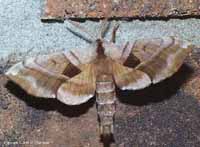 |
The adults are also highly variable; sometimes wings of an individual
may be all one color or may have several colors, ranging from pale to
dark brown, and may have a white or pink tinge. Patterns range from
faint to pronounced.
|
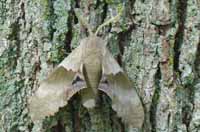 |
Pachysphinx modesta
WO,
the Modest Sphinx or Poplar Sphinx
This moth has a large, heavy body, and females can be remarkably
plump.
Larvae are fond of poplars and willows.
|
 |
This one is quite similar to Pachysphinx modesta, with modesta
being smaller and darker. The am and pm lines are distinct in occidentalis,
diffuse in modesta.
Moths should be on the wing from June-August.
|
 |
The outer margin of the forewing is quite wavy. There is a dark cell spot and a dark oblique line mid wing from the costa almost to the
inner margin. Basic ground colour is pinkish brown. Flight would be June-July.
unlikely
|
 |
This small species is probably widespread and common. This species ranges across North America.
The hindwings have a small blue eyespot ringed with black on a yellow background.
|
 |
Smerinthus cerisyi
BAMONA, the Cerisyi's
Sphinx or One-eyed Sphinx, Larvae feed on poplars and willows.
Flight would be from late May-July as a single brood.
|
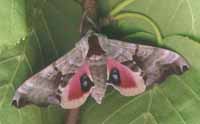 |
Smerinthus jamaicensis closely resembles Smerinthus cerisyi, but
jamaicensis is much smaller with larger blue patches on
more vibrant and deeper purple in the lower wings.
|
Macroglossinae subfamily
Dilophonotini tribe:
 |
Hemaris diffinis WO,
the Snowberry Clearwing or Bumblebee Moth
The wings are basically clear, with dark brown to brownish-orange
veins, bases and edges. The thorax is golden-brown to dark
greenish-brown. The abdomen tends to be dark (black) with 1-2 yellow
segments just before the end.
|
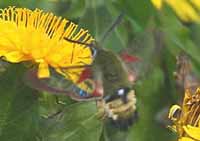 |
Hemaris senta
WO,
the Rocky Mountain Clearwing. There is probably a single brood of this montane species from
May-August.
The moth is seen along streamsides and in meadows in
mountainous areas. I believe this moth is now classified as H. thetis. |
Philampelini tribe:
 |
Eumorpha achemon
WO,
the Achemon Sphinx
Adults nectar from flowers of Japanese honeysuckle
(Lonicera japonica), petunia (Petunia hybrida),
mock orange (Philadelphus coronarius), and phlox (Phlox).
Larvae feed upon Grape (Vitis),
Virginia Creeper (Parthenocissus quinquefolia)
and other vines and ivies (Ampelopsis).
|
Macroglossini tribe:
 |
Darapsa myron
WO, the Virginia Creeper Sphinx or the
Grapevine Sphinx.
The forewing upperside is dark brown to pale yellowish gray, with an
olive tint. On the costal margin there is a dark rectangular patch,
although this may be reduced or absent. The upperside of the hindwing
is pale orange.
|
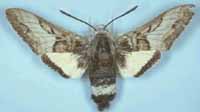 |
Euproserpinus wiesti adults fly, during the day, over sand washes
and prairie
blow-outs as a single brood from May-June.
|
 |
Hyles lineata WO, the White-lined Sphinx
This species is very widespread. It can be seen flying during the day,
into the evening and also at night.
The highly variable larvae are often found in people's gardens. |
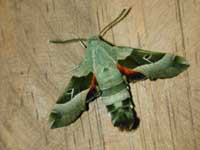 |
The upperside of the forewing is pale gray-green with a deep
green-brown median area and a white dash at the wing tip. The
underside of the forewing is pale orange at the base.
|
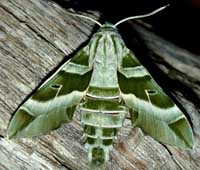 |
Jim Tuttle writes, "P. vega has a very large and dark basal
patch as the FW meets the thorax that is lacking in terlooii.
There are also three prominent longitudinal
stripes on the thorax of vega that are lacking in
terlooii."
|
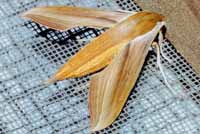 |
Xylophanes tersa possible stray
WO,
the Tersa Sphinx
The upperside of the forewing is pale brown with lavender-gray at the
base and has dark brown lengthwise lines throughout. The upperside of
the hindwing is dark brown with a band of whitish, wedge-shaped
marks.
|
|
|
